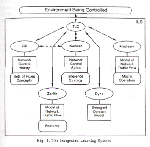

Temi Rose
Analysis of IT Research/ Paper 1
Copyright October 1997
I am an artist whose primary contribution to education has been in the design of learning programs for target populations who are categorized by funding organizations as underprivileged or at-risk. The target populations I have worked with have had certain characteristics in common: 1) They are uncomfortable in standard educational environments 2) They have short attention spans 3) They have severe problems dealing with authority (either they are too submissive or extremely rebellious).
Taking the above characteristics into consideration, the programs I have been working on have been 1) not on the site of conventional educational institutions 2) interactive and varied and 3) constructed with an emphasis on high levels of dialogue, interaction and flexibility.
Delivering effective education to the above described target populations is extremely demanding on the teachers. In general we found that the pressures involved in delivering programs complex enough to be compelling to these students and with results commensurate with the goals of the funding agencies, limited our choice of teachers: Very few teachers have both the flexibility, in terms of variety of teaching strategies available to them (meta-cognitive creativity) and the knowledge scope necessary to dialogue with students on subjects relevant to their lives.
One possible solution seems to be to systematize this instruction, to limit the demands made on the teacher/instructor to a level more comparable to those faced in normal classrooms. There are three main reasons to systematize these programs:
1) to increase the number of teachers who will be willing and able to work with these populations
2) to optimize and regularize the quality of the information, knowledge, training available to these students (a need expressed by business, government and institutions of higher learning)
3) to deliver education on sites remote from large educational institutions (a need expressed by both learning populations and educational institutions).
In this paper I am primarily concerned with the process of systematization that will optimize and regularize the quality of the information, knowledge and training available (#2 listed above). I believe that the systems being designed in the fields of artificial intelligence, intelligent systems, expert systems, robotics, and adaptive intelligent systems are generalizable and thereby have applicability and transferability to the design of portable (distance), relevant (quality) educational systems.
Section 1: An Overview of Artificial Intelligence Systems Research will provide an overview of artificial intelligence research. Section 2: Application of Selected Research Findings to Educational Systems- will describe findings from thirteen research reports; the focus being knowledge architectures (ways of organizing and processing information to do work in the real world/to act on the external environment). In each case I will draw analogies to how these architectures might be applied to educational purposes. The conclusion will review the aspects of artificial intelligence research most salient to educational systems design.
According to Goodall (1985) and David et. al. (1993) the early designers of artificial intelligence systems were concerned with generating universal solutions, generic systems, a 'general purpose problem solver' (Goodall:54). When these efforts failed, attention shifted to the heuristics of real world problems. This focus has been beneficial to AI research both because the architecture of most AI systems is developed logically from the real demands of its use and because practical applicability generates funding. AI systems have been developed for use in manufacturing, medicine, space exploration, military weapons systems and nuclear reactors.
Romiszowsky (1981:178-9) cites Landa as categorizing computerized systems as follows:
1) Linear programs (e.g. ruleg and eg-rule)
2) Intrinsic programs (e.g. 'branching text')
3) Extrinsic programs (can recognize and respond to 'learner patterns')
4) Adaptive programs (can 'recognize and react' to learner in real time)
5) Structure-diagnostic programs (can react and analyze learner mistakes)
AI systems are structured as combinations of several of the above listed systems or complex (deep/layered/hierarchical) constructs of single methods. In all cases AI systems are designed to interact with a dynamic environment
AI systems that are required to interact with human experts are designed with an English-language interface. AI systems generally work in tandem with other systems (human and machine) and therefore must be able to receive and act on incoming data.
At present no AI system operates without human interaction at some stage; in fact AI systems are designed to work in partnership with humans, providing extreme speed, accuracy or access to information that might be difficult or impossible for their humans partners to achieve.
According to Goodall (1985) when conventional programming was found to be too laborious, too slow, to function efficiently at the levels of complexity necessary in AI niches, new types of programming were developed. AI designers looked to philosophy and cognitive science in an attempt to create dynamic 'thinking' systems. For instance, Bertrand Russell's mathematical formulations of philosophical postulates and Noam Chomsky's formulas for linguistic analysis were used to create AI programming. AI techniques based on these philosophies are referred to as symbol systems and often represented and manipulated through the use of formulas. Hence in AI systems research one finds references to cognitive theory, philosophy, the function and methods of human thought, and the purpose and structure of biological life.
Another branch of AI research bases its architecture on object-modeling and visual codification techniques. Some researchers find that it is more efficient to transfer information in coded 'chunks' rather than through linear programming (lists). These 'chunks' are occassionally manipulated as graphics and schema and often in conjunction with formulaic reasoning.
Typical of all computer research, AI research is concerned with speed. Atypically, AI research must concern itself with 'real-time'. The ability to react to stimuli and/or information received from the environment or from human partners is a basic characteristic of all AI sytems.
Restricting information overload, selectivity amidst the theoretically infinite amount of incoming data is a necessity in AI systems design. Effective AI architectures must handle information flow efficiently.
In most AI niches there is a variety of types of information that must be correlated. The order and the manner in which these correlations occur is the central design issue of AI architectures.
Of special interest in real-time heuristics is a development of AI research called blackboard architecture. The salient feature of blackboard architecture is its ability to change strategies and control modes dynamically as a result of information it receives in real-time. Aspects of this architecture have been adopted and highly classified by the military for use in weapons systems deployment scenarios.
Several advances in AI architectures have led to the creation of shells which can be filled with different knowledge domains. For instance from MYCIN came EMYCIN (which is an acronym for 'empty mycin'). EMYCIN has the same architecture as MYCIN but can accomodate different knowledge domains.
There has also been an interest in AI to create systems that will run on smaller computers, accessible to a more general public. According to Goodall (1985) these architectures are engineered on large main frame computers and then simplified to run on smaller, more readily available computer systems.
In sum, AI systems are already being used to successfully run machinery, robots and information and weapons systems.
AI systems are always used in conjunction with human partners.
In some instances the AI system's knowledge base is generated by knowledge engineers interviewing subject experts. In these instances the goal is to make more widely available and accessible knowledge which is perceived as rare and necessary to archive. In these instances the goal is to further extend and disseminate human achievement and knowledge.
In other cases the knowledge base is generated purely hypothetically - for instance when a machine is meant to execute a task that would be impossible (because of speed or location) for a human to perform. In these instances the goal is to extend ourselves beyond the limitations of human physicality.
Silver at. al. (1993) have created 'a framework for combining various learning paradigms, integrating different reasoning techniques and coordinating.. cooperative problem solvers.' They call their framework ILS: Integrated Learning System. They describe their framework as 'domain independent.' In this case the researchers have begun with a 'shell' that has theoretically limitless applicability. It's flexibility consists in its maintenance of a variety of problem solving programs and integrating their results. Fig 1 below illustrates their framework applied to a traffic control problem.

A system like ILS could be of benefit in a learning environment. Students and teachers would be able to work different, similar or related aspects of an integrated program. The ILS design would allow individuals to approach problems using a variety of reasoning techniques. ILS also has the potential of correlating responses and producing an analysis of the work that was done.
According to Silver et. al. (1993:74) 'ILS integrates implementations of [several] learning paradigms, and TLC [The Learning Coordinator]. The learning paradigms are: inductive..., macro-learning..., and knowledge-based learning..., feature-learning..., and reactive-planning.'
Meijer et. al. (1990:217) developed a Procedural Expert System. PES is an architecture which can 'control ..a robot in a partly-structured environment...' Their architecture monitors 'robot activities and .. handle[s] exceptions. The control system must be reactive to new situations.' PES is 'based on the Exception Handling Model.'

Figure 6 above illustrates the complexity of Meijer et. al.'s perceptual and control interface.
The applicability of the PES model to educational systems design is in its realization that mistakes are inevitable; and dealing with mistakes can be integrated into the basic structure of design.
Meijer et. al. (1990:217) explain that, 'Recent research directions have...moved away from the a-priori plan generation and study on-line plan generation based on some external events. The systems studied here are not constrained by any plan information apart from a task description and are therefore on the other end of the spectrum compared to the plan-driven ' systems.
Cognition is a complex activity. According to David et. al. (1993:4) 'solving complex problems has always been the hallmark of artificial intelligence.'
Karbach et. al. (1993:721) have developed a language called MODEL-K, 'To close the gap between knowledge level and symbol level... Systems written in MODEL-K contain their conceptual model, making them more transparent, easier to communicate to the expert, to explain to the user, and to maintain by the knowledge engineer.'
The essence of cognition, according to theorists as diverse as Socrates and Vygotsky, is dialogue. Communication between the system and the users of the system is desirable in educational environments because communication is about increasing the dialogue which increases cognitive ability: learning.
Coiffet et. al. (1990:419) state that 'No living being seems to use precise computation when it performs acts in its lifetime.. We have to conclude with the idea that a basically qualitative control is better adapted to robot control than a quantitative one.'
In figure 4 below we see an illustration of how their system allows the user to loop back in case of error or incomplete actuation.
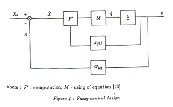
Pierce et. al. (1997:169) have developed 'a set of methods by which a learning agent [robot] can learn a sequence of increasingly abstract and powerful interfaces.. [the agent] uses a generate and test approach.'
In their experiments robots were given no a-priori knowledge of their environment. Programmed only with knowledge of their own internal systems (1997:221) 'Each abstract interface that the agent learns provides a new representation to reason with.'
Pierce et. al. (1997) are essentially using a spiral technique to reinforce right answers and 'wash out' uncertainty. The spiral model has often been used in education but not with such high tech formulations.
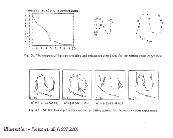
Najork (1996:219) has developed 'Cube,... a three-dimensional, visual, ... higher-order logic programming language designed to be used in a virtual-reality-based programming environment.'
Najork states that 'the central argument in favor o visual languages is that humans are known to process pictures easier and faster than text. According to Raeder, 'it is commonly acknowledged that people acquire information at a significantly higher rate by discovering graphical relationships in complex pictures than by reading text.'
Figure 13 and 14 illustrate the flow of information through Cube:
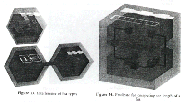
Najork asserts that Cube is able to handle more information more efficiently than non-visual languages. He also states that 3D programming better utilizes screen space.
With regards to educational systems I believe that 3D languages and systems designs will be useful in education both with semi-literate populations as well as with advanced students - both require complex and detailed examples of real world objects and situations.
Also, the ability to navigate by using 3D visual cues will allay some of the mental claustrophobia that we all feel when faced with computer software designed in linear logic patterns.
'The hyperbolic browser' was developed at PARC (the free-wheeling, independently managed, experimental division of IBM) for Xerox Corp.
Lamping et. al. (1996:33) describe the hyperbolic browser as 'a new focus and context technique inspired by the Escher woodcut shown in figure 2 [see below]'.
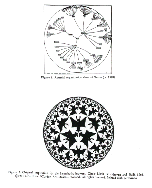
This imaginative design is an attempt to manage large data constructs through the use of self-explanatory 'trees'. The researchers propose to use their browser for Xerox Corp.'s web pages.
Lamping et. al.'s (1996) design could be utilized effectively in educational contexts in which a great deal of information needs to be easily accessible.
Another benefit of this design is the maintenance of the relationships of data; as the pointer moves, the user can go deeper into any part of the tree without destroying the relationships inherent in the larger structure.
The illustration below gives two more examples of Lamping et. al.'s (1996:38) tree structures:

Hideyuki et. al.'s (1997) conceptual structure allows them to handle the problem of information overload at a very basic level: their system is designed to ignore irrelevant information.
Their concept could be used to buffer an educational system to deal with the inevitable: mischievous students trying to flood the system with irrelevant 'noise'.
Poole (1997:7) has developed Independent Choice Logic. ICL 'is a semantic framework that allows for independent choices (made by various agents, including nature) and a logic program that gives the consequences of choices.'
Clearly, in educational contexts it is useful for users of systems to be aware of the 'consequences of their choices.'
Of further interest, Poole states that (1997:10) 'An agent is something that acts in the world. An agent can, for example, be a person, a robot, a worm, the wind, gravity, a lamp, or anything else. Purposive agents have preferences - they prefer some states of the world to other states- and act in order to (try to) achieve worlds they prefer.'
Poole's platform supports game-like interactions which I, and many other educators, feel could have tremendous applicability and implications in educational environments. Games could alleviate the problem of short attention spans by involving students directly. Games can communicate many layers of information and allow the user to participate, to actively use the information. Many learning theorists believe that we learn more when we can apply our knowledge to events and circumstances. Games are simulations of events and circumstances. Sutton-Smith (Pellegrini 1995) argues that games carry within them the values of the culture they come from, another bonus?
Cuena (1993) has developed architectures which aim to support real-time decisions necessary to manage physical systems.
Figure 1 below gives an example of the reasoning structure of one of his designs.
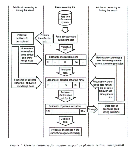
Cuena (1993:689-690) states that 'the quality of knowledge to be introduced into the system ...[should] be improved because- Improved explanation capability is required.. in the case of.. Education applications, where the student must know the reasons that justify an answer to both understand the right knowledge to be used and the right way to use it. In these cases the quality of the knowledge presented in the explanations is the real quality of the system.'
I agree with Cuena here but I would not underestimate the architecture's, the flow's, affect on the quality of the system. If the quality of the information in an educational system is excellent but the knowledge is difficult to access or linked poorly within the system, the power of the information as a learning tool can be completely obliterated.
Tzasfestas and Tzasfestas (1990:285) use blackboard architectures to design 'integrated ..knowledge-based systems.' Their definition of blackboard architecture is illuminating: 'Blackboard architecture ..belongs to the class of distributed problem solving architectures, and employs more than one problem solving agent. The three basic elements of blackboard architecture are - the blackboard, the knowledge sources and the control mechanism. The blackboard plays the role of a central working memory within the system and the controller stands for the conflict resolution mechanism. The knowledge about the system (problem) is split in a number of comparatively small bases called knowledge sources and controlled through the blackboard control scheduling) mechanism which is usually a meta-knowledge control mechanism. This mechanism is not committed to any reasoning technique (e.g., forward or backward chaining), but has a rather opportunistic nature (i.e., the control action is determined by the optimal decision taken at each cycle of operation).'
Not only is the metaphor of the blackboard evocative of the flexibility of the best classroom teaching, the real-time decision capabilities of blackboard architecture will make it useful for effective teaching and learning system paradigms.
Hayes-Roth (1993) provides a clear diagram of her application of a blackboard architecture to what she calls an 'adaptive intelligent system,' Guardian, an ICU (intensive care unit) monitoring agent.
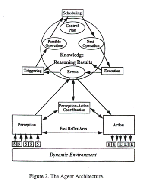
Hayes-Roth's (1993:2) systems deal with 'situations that vary dynamically..' sounds like a description of a classroom to me!
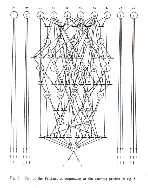
Figure 9 above is an example of a Petri-Net. This organization is a design concept which was conceived as an empty net structure, a shell design that can be used for different applications.
Figure 5 below is an example of one of Saridis' (1990:570) designs for intelligent machines. Saridis is a designer who formulates his concepts analytically, based on principles. He designs systems primarily for NASA.
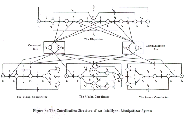
I think that analytically designed systems can have a great deal of power both by clarifying the work that is derived from real world applications and in extending the possibilities of architectures to worlds not yet explored.
The power in creating systems analytically is not a new concept. Florence Nightingale only went into battlefields once or twice. After she had witnessed the conditions, the general characteristics of battle arenas, she was able to design hospitals and nursing systems for Red Cross units all over the world - using the data sent to her from the field to her office in London.
Jane Addams, in contrast, stayed in Chicago developing Hull House and her system of social welfare 'on the spot'.
It is possible to argue that Nightingale's system has had a greater impact and longevity than Hull's system, in no small part because Nightingale's system was analytically derived and therefore has been easily transferred to new situations and circumstances.
It seems beneficial to me to design educational systems with at least a modicum of analytical theory to increase the chances of effective transferability and generalized applicability.
According to Tzasfestas and Tzasfestas (1990:285) 'Artificial Intelligence may be defined as the science of enabling computers to learn, reason, and make judgment.. One might argue that AI has now started to build systems that are able to display human-level intelligence in certain domains. These include 'knowledge-based systems' which are appropriate for specialized tasks and formed the branching point away from the quest for generality that characterized early AI. Furthermore, the so-called 'knowledge-engineering' (i.e., knowledge extraction from human experts) slowly became refined,... another reason for AI's current domination might be traced to AI's undertaking practical issues... AI technology offers the tools that enable us to: (i) capture and retain expertise...(ii) amplify expertise that is needed to successfully deploy new methods and applications ; and (iii) design systems that reason intelligently about necessary actions to take in real time, thus freeing operational staff.'(i), (ii), and (iii) are purposes that could be lifted verbatim and applied to educational contexts.
McLeod's educational research is referred to in Briggs et. al. (1981:107): When McLeod 'asked when teachers use objectives.. she found that teachers formed 26.5% of their objectives before choosing activities or selecting materials and formed 19.5% of their objectives after planning, but before teaching, a total of 46% before teaching. Teachers formed 45.8% of objectives during the act of teaching and 8.2% of their objectives during reflection after teaching. McLeod found that 57.7% of the objectives formulated were cognitive, 35% were social or affective, and 7.2% were psychomotor or perceptual. The social outcomes were identified during teaching, while the cognitive outcomes were identified before and after teaching. Thus, McLeod's research supports the assertion that teachers use objectives in a flexible and continuous manner, varying their planning depending on the type of objective.'
The AI systems could provide the flexibility that the teachers in McLeod's study appear to need.
In the spirit of the AI designers who looked to philosophy for insights into structuring of their systems, I suggest that instructional designers look to the advances made by AI research. I think that the cross-fertilization has already begun and it's now inevitable for the findings of AI research to return the favor and influence education, social science and the humanities. AI research has managed to codify aspects knowledge to do work in real time in a real world. These codifications are bound to have applicability to many aspects of educational systems design.
The division between technical and academic training that haunts our educational systems could find a unifying paradigm in AI design: In essence all education is interactive and applied.
Knowledge systems for AI offer us templates to experiment with when structuring knowledge systems for educational environments. AI designers are designing machines to work with people. Instructional designers are doing the obverse: designing human systems that can work effectively with machines.
With respect to the characteristics of the target populations I work with: AI designs provide models for learning in remote sites. AI systems make it possible to vary both the approach and content to deal with the challenges of short student attention spans and the need for relevance. The truly interactive possibilities of AI systems might be utilized to build confidence in learners: High levels of responsiveness in the system means that the student never need be labeled 'wrong'. We can design a system that allows a student to approach the problem from many different paths using many different cognitive methods until we arrive at an understanding. Rebellious students could be stimulated and challenged by these highly responsive programs. When rebellious students feel ignored and bored they assert their individuality. If the students' individuality can be addressed at every level and stage of their educational experience they may find it easier to become comfortable with their own inner authority.
Responsive, flexible, and adaptive systems could free teachers to deal with the more subtle human issues that are crucial in any learning environment but especially critical with at-risk populations.
In general I believe that AI designs, AI programs and even the architectures themselves will influence the models, programs and architectures that we will be using in educational systems design in the near future and for a long time thereafter.
Ball, S. (Ed.) (1977) Motivation in Education. Academic Press.
Briggs, L., Gustafson, K. & Tillman, M. (Eds.) Instructional Design; Principles and Applications (2nd ed.) Educational Technical Publications.
Coiffet, Ph., Zhao, J., Zhou, J., Wolinski, F., Novikoff, P., & Schmit, D. (1991). About Qualitative Robot Control. In J. David, J. Krivine, R. Simmons (Eds.) Expert Systems And Robotics (pp. 419-444) Springer-Verlag.
Cuena, J. (1993). Knowledge Architecture for Real Time Decision Support. In J. David, J. Krivine, R. Simmons (Eds.) 2nd Generation Expert Systems (pp. 689-720) Springer-Verlag.
David, J., Krivine, J., & Simmons R. (1993). Second Generation Expert Systems: A Step Forward in Knowledge Engineering. In J. David, J. Krivine, R. Simmons (Eds.) 2nd Generation Expert Systems (pp. 3-23) Springer-Verlag.
Dick, W. & Carey, L. (1996) The Sytematic Design of Instruction. (4th ed.) Harper Collings College Publishers.
Gagne, R.M. (1977) The Conditions of Learning and Theory of Instruction. (3rd ed.) Holt, Rinehart & Winston.
Goodall, A. (1985) The Guide to Expert Systems. Learned Information.
Hayes-Roth, B. (1993). An Architecture for Adaptive Intelligent Systems Report No. STAN-CS-TR-93-1496 /#KSL 93-19 Department of Computer Science, Stanford University.
Hideyuki, N., Hitoshi, M., & Ichiro, O., (1997) Causality as a key to the frame problem.Artificial Intelligence., 91, 33-50.
Hodgkin, R.A. (1985) Playing and Exploring; Education through the discovery of order. Methuen.
Johnson, K., & Foa, L. (Eds.) (1989) Instructional Design; New Alternative for Effective Education and Training. Nucea/MacMillan.
Karbach, W., Vob, A. (1993). MODEL-K for prototyping and strategic reasoning at the knowledge level. In J. David, J. Krivine, R. Simmons (Eds.) 2nd Generation Expert Systems (pp. 721-745) Springer-Verlag.
Lamping, J. & Rao, R. (1996). The Hyperbolic Browser: A Focus + Context Technique for Visualizing Large Hierarchies. Journal of Visual Languages and Computing, 7, 33-55.
Meijer, G.R., Mai, T.L., Glaussens, E., Hertzberger, L.O., & Arlabosse, F. (1991). Robot Control with Procedural Expert System. In J. David, J. Krivine, R. Simmons (Eds.) Expert Systems And Robotics (pp. 217-232) Springer-Verlag.
Metcalf, J. & Shimamura A. (Eds.) (1994) Metacognition; Knowing about knowing. MIT Press.
Najork, M.A. (1996). Programming in Three Dimensions. Journal of Visual Languages and Computing, 7, 219-242.
Pellegrini, A. (Ed.) (1995) The Future of Play Theory; A Multi-disciplinary Inquiry into the contributions of Brian Sutton-Smith. State University of New York Press.
Pierce, D., Kuipers, B. (1997) Map learning with uninterpreted sensors and effectors. Artificial Intelligence, 92, 169-227.
Poole, D. (1997) The independent choice for modelling multiple agents under uncertainty. Artificial Intelligence, 94, 7-56.
Raczkowsky, J., Seucken, K., (1991). Sensor Planning for the Error Diagnosis of Robot Assembly Tasks. In J. David, J. Krivine, R. Simmons (Eds.) Expert Systems And Robotics (pp. 127-134) Springer-Verlag.
Reynolds, G. & Jones, E. (1997) Master Players; Learning from Children at Play. Teachers College Press.
Romiszowski, A.J. (1981) Designing Instructional Systems; Decision Making in Course Planning and Curriculum. Kogan Page.
Saridis, G. (1991). On the Theory of Intelligent Machines. In J. David, J. Krivine, R. Simmons (Eds.) Expert Systems And Robotics (pp. 551-579) Springer-Verlag.
Silver,B., Vital, J., Frawley, W., Iba, G., Fawcett, T., Dusseault, S., & Doleac, J. (1993). A Framework for Integrating Heterogeneous Learning Agents. In J. David, J. Krivine, R. Simmons (Eds.) 2nd Generation Expert Systems (pp. 746-764) Springer-Verlag.
Tiffin, J. & Rajasinghan, L. (1995) In Search of the Virtual Class; Education in an Information Society. Routledge.
Tzafestas, S. & Tzafestas, E. (1991). The Blackboard Architecture in Knowledge-Based Systems. In J. David, J. Krivine, R. Simmons (Eds.) Expert Systems And Robotics (pp. 285-318) Springer-Verlag.
Weinert, F.E. & Kluwe R.H. (1987) Metacognition, motivation and understanding. Lawrence Erlbaum Association.
temirose@mail.utexas.edu
